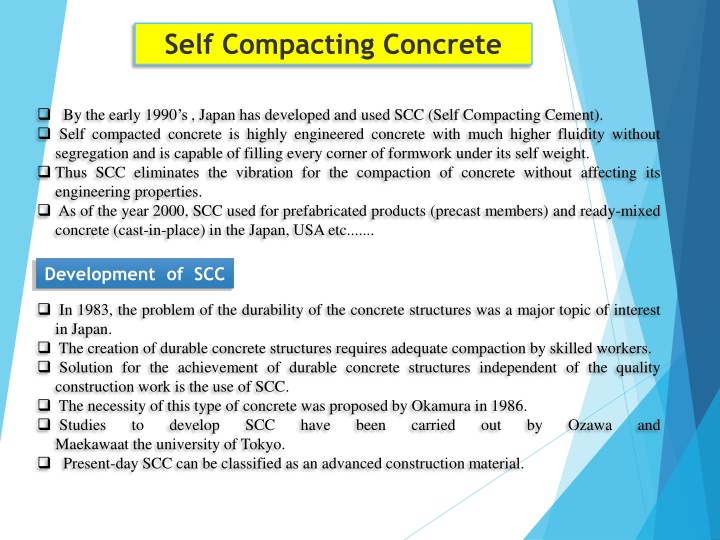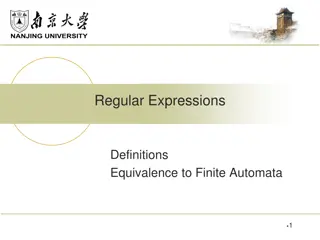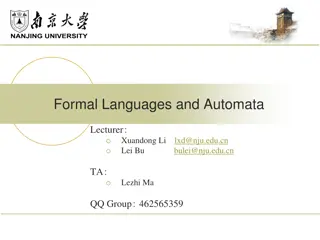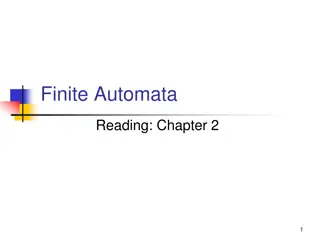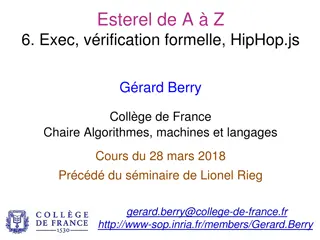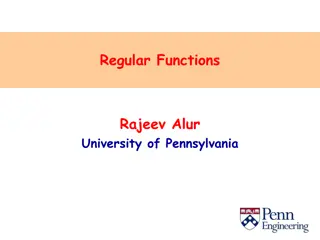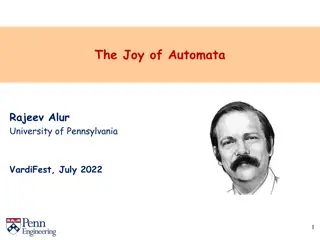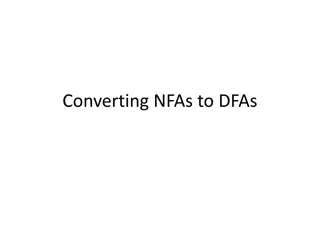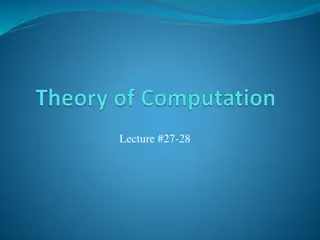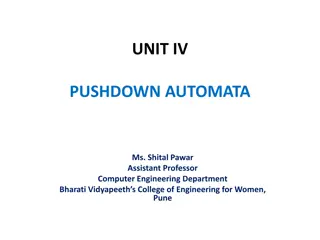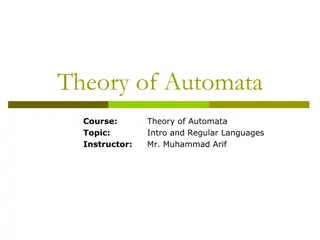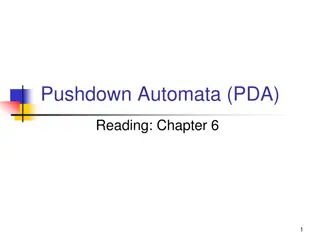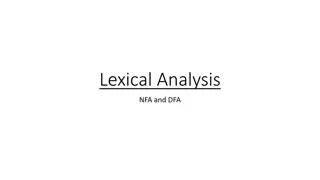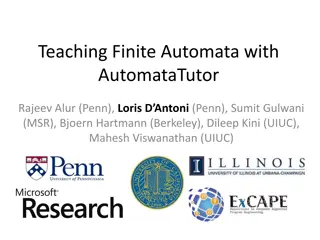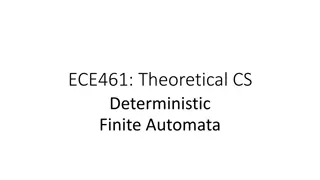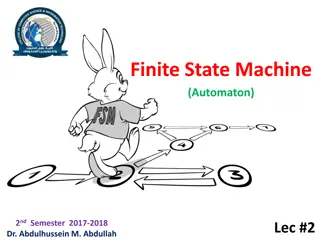Introduction to Finite Automata and Recognizers
Finite Automata (FA) are graphical models used to compile regular expressions into recognizers capable of determining if a given string is part of a specific language. Non-deterministic Finite Automata (NFA) allow for multiple transitions from a state on the same input symbol, while Deterministic Finite Automata (DFA) ensure only one transition per state per input symbol. Learn about the conversion of NFAs to DFAs and how they recognize languages.
Download Presentation

Please find below an Image/Link to download the presentation.
The content on the website is provided AS IS for your information and personal use only. It may not be sold, licensed, or shared on other websites without obtaining consent from the author.If you encounter any issues during the download, it is possible that the publisher has removed the file from their server.
You are allowed to download the files provided on this website for personal or commercial use, subject to the condition that they are used lawfully. All files are the property of their respective owners.
The content on the website is provided AS IS for your information and personal use only. It may not be sold, licensed, or shared on other websites without obtaining consent from the author.
E N D
Presentation Transcript
Self Compacting Concrete By the early 1990 s , Japan has developed and used SCC (Self Compacting Cement). Self compacted concrete is highly engineered concrete with much higher fluidity without segregation and is capable of filling every corner of formwork under its self weight. Thus SCC eliminates the vibration for the compaction of concrete without affecting its engineering properties. As of the year 2000, SCC used for prefabricated products (precast members) and ready-mixed concrete (cast-in-place) in the Japan, USA etc....... Development of SCC In 1983, the problem of the durability of the concrete structures was a major topic of interest in Japan. The creation of durable concrete structures requires adequate compaction by skilled workers. Solution for the achievement of durable concrete structures independent of the quality construction work is the use of SCC. The necessity of this type of concrete was proposed by Okamura in 1986. Studies to develop SCC have Maekawaat the university of Tokyo. Present-day SCC can be classified as an advanced construction material. been carried out by Ozawa and
Why it is needed? Concrete is a versatile material, extensively used in construction material throughput everywhere. Properly placed and cured concrete exhibits excellent compressive-force-resisting characteristics and reliable for myriad situations. If proper consolidation is not provided, its strength and durability could be questionable. Use of concrete in special architectural configurations and closely spaced reinforcing bars. Properties of SCC Filling ability The ability of the SCC to flow under its own weight into the mould and fill all spaces within intricate formwork, containing obstacles , such as reinforcement. Passing ability The ability of SCC to flow through opening approaching the size of the mix coarse aggregate, such as the spaces between steel reinforcing bars, without segregation. Resistance to Segregation The ability of SCC to remain homogeneous during transport placing , and after placement.
Mix design principles The flow ability and viscosity of the paste is adjusted by proportioning the cement and additive water to powder ratio and then adding super-plasticisers and VMA (Viscosity modifying admixtures). The paste is the vehicle for the transport of the aggregate, therefore the volume of the paste must be greater than the void volume in the aggregate. In order to control the temperature rise and thermal shrinkage cracking as well as strength, the fine powder should be added to keep the cement content at an acceptable level .e.g.., fly ash, mineral filler, silica fume, GGBFS (Ground- granulated blast-furnace slag) SCC should have o Low coarse aggregate content o Increased paste content o Low water powder ratio o Increased super-plasticizer dosage o Viscosity modifying agents
Mechanism for achieving self- compactability The method for achieving self-compacting involves not only high deformability of paste or mortar, but also resistance to segregation between coarse aggregate and mortar when the concrete flows through the confined zone of reinforcing bars. 50% OF SOLID VOLUME LIMITED GRAVEL CONTENT APPROPRIATE MORTAR 40% OF MORTAR VOLUME LIMITED SAND CONTENT HIGHIER DEFORMABILITY HIGHIER DOSAGE OF SP LOWER W/C MODERATE VISCOSITY
The frequency of collision and contact between aggregate particles can increase as the relative distance between the particles decreases and then internal stress can increase when concrete is deformed, particularly near obstacles. Research has found that the energy required for flowing is consumed by the increased internal stress, resulting in blockage of aggregate particles. Limiting the coarse aggregate content, whose energy consumption is particularly intense, to a level lower than normal is effective in avoiding this kind of blockage. Mechanism for achieving self- compatability
Highly viscous paste is also required to avoid the blockage of coarse aggregate when concrete flows through obstacles . When concrete is deformed, paste with a high viscosity also prevents localized increases in internal stress due to the approach of coarse aggregate particles. High deformability can be achieved only by the employment of a super-plasticizer, keeping the water-powder ratio to a very low value. The degree of packing of coarse aggregate in SCC is approximately 50% to reduce the interaction between coarse aggregate particles when the concrete deforms. The degree of packing of fine aggregate in SCC mortar is approximately 60% so that shear deformability when the concrete deforms may be limited. On the other hand, the viscosity of the paste in SCC is the highest among the various types of concrete due to its lowest water-powder ratio. This characteristics is effective in exhibiting segregation. Typical mix proportion values
Types of test Test to be carried out 1. Slump test 2. L-Box test 3. J-ring 4. Sieve ability test 5. V-funnel 6. Orimet 7. Penetration test Property to be determined Filling ability Passing ability Passing ability Resistance to segregate Filling ability Filling ability Resistance to segregation Advantages :- a) It can be placed at a faster rate with no mechanical vibration and less screening. b) Improved and more uniform architectural surface finished with little to no remedial surface work. c) Ease of filling restricted sections and hard to reach areas results in achieving desired structural and architectural shapes. d) Improved consolidation around reinforcements and bond with reinforcement. e) Improved uniformity of in-place concrete by eliminating variable operator- related effort of consolidation. f) Shorter construction periods and resulting cost saving and less labour works.
Disadvantages:- a) More stringent requirements on the selection of materials b) More precise measurement and monitoring of the constituent materials. c) Requires more trial batches at laboratory as well as at ready-mixed concrete plants. d) Costlier than the conventional concrete based on concrete material cost (exception to placement cost). e) Lack of globally accepted test standards and mix designs.
